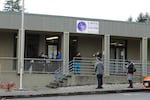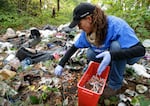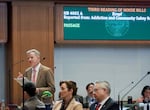Perhaps this sounds familiar.
In 2021, lawmakers in Washington state were looking for a way to reintroduce criminal penalties for drug possession.
The politicians didn’t want to revert to a destructive drug war. So they designed a system where, yes, offenders could be arrested and charged for possessing drugs – but maybe they wouldn’t have to be. The new law carved out a path for police to steer users toward social services rather than taking them to jail.

FILE - Patients line up to pick up medication for opioid addiction at a clinic in Olympia, Wash., on March 27, 2020. In 2021, lawmakers in Washington state started the Recovery Navigator Program, a new law that carved out a path for police to steer users toward social services rather than taking them to jail.
Ted S. Warren / AP
In the Evergreen State, this effort had a formal title: the Recovery Navigator Program.
Oregonians are about to know it by another name: deflection.
Three years after Washington was forced to retool its drug policy by a surprise court ruling, Oregon is on the verge of a change that, if you squint, looks roughly identical.
Oregon policymakers weren’t forced into action by judges. It was the court of public opinion that prompted them to reintroduce criminal penalties for possessing small amounts of drugs.
But just like Washington, the Beaver State is hoping that the impact on jails and courts will be muted when the new criminal penalties kick in Sept. 1. Like our neighbors to the north, the Legislature has urged counties to “deflect” people toward services when they’re caught with illegal drugs.
No one can say for sure how that major shift will go. But Washington’s experience offers clues – and cautions.
Some of the people at the heart of that process believe Oregon is on the verge of making critical mistakes that mean many parts of the state will flop when it comes to meeting the overarching goal: steering drug users who are causing public angst and disorder away from the public eye and toward recovery.
By giving individual counties leeway to design their own programs, rather than requiring them to adopt a proven approach as Washington did, they say the outcomes around Oregon are likely to be wildly uneven – at least until local officials realize things aren’t working. In the meantime, Oregon is so far spending around $20 million on the experiment.
“If you’re going to pump a bunch of money into something, make sure that what you think you’re buying is what you’re actually getting,” said Washington state Rep. Lauren Davis, a Seattle-area Democrat who helped author her state’s law. “Why are you going to take a stick and scratch in the dirt and try to come up with some new-fangled program?”
The Blake “grenade”
Three years ago, Davis was looking to Oregon as a source of inspiration. She had been watching the state’s voter-approved drug decriminalization law, Measure 110, and decided to attempt a Washington-style approach.
Unlike Oregon’s botched rollout, however, Davis wanted to be intentional. Her proposal would have created a robust network of support services throughout Washington that could help drug users navigate their recovery. Only then would the state decriminalize possession.
The Washington Supreme Court had other plans.
In February 2021, the court handed down a decision that upended Washington’s drug landscape. In the case of State v. Blake, judges found that the state’s criminal drug possession laws were unconstitutional, since they allowed a person to be convicted even if they did not know they had drugs on them. With the ruling, Washington suddenly had no crime against possession.
“It was kind of like a grenade thrown into the middle of the legislative session,” said Washington state Rep. Roger Goodman, a Kirkland Democrat who chairs a legislative committee that focuses on criminal justice matters. “Most of us, at least on the Democratic side, thought it was an opportunity to innovate in drug policy.”

FILE - In this Nov. 8, 2017 file photo, a volunteer outreach worker with an addiction and homeless advocacy group cleans up needles used for drug injection that were found at a homeless encampment in Everett, Wash.
Ted S. Warren / AP
But Washington lawmakers were also under pressure to act fast. As they rushed to pass a stopgap bill to reinstate consequences for drug possession, Davis saw an opportunity to kickstart a piece of the system she’d envisioned. The Recovery Navigator Program was born.
The RNP, as it’s known, was really just the expansion throughout Washington of a model that Seattle had used for a decade to help guide drug users toward treatment and away from criminal consequences.
Called Law Enforcement Assisted Diversion, or LEAD, the program has won a measure of national acclaim. It’s rooted in the idea that repeated arrest and prosecution do little to help people mired in addiction. Under LEAD, social service providers and law enforcement agencies work closely together to strategize how best to get drug users (and others with complex needs) to a better place.
Since its inception in 2011, the LEAD model has spread to dozens of jurisdictions across 23 states.
And research from around the country strongly suggests it works. People who opt to accept services and meet routinely with case workers under the LEAD model are arrested less often, see fewer future convictions, and experience fewer hospital stays – all while being connected to a support structure that assists them in accessing treatment when they are ready.
Even with that track record, the name Law Enforcement Assisted Diversion wasn’t popular in 2021, when the political climate in many progressive parts of the country was focused on restraining police powers.
“At that time, suggesting that the state should spend tens of millions of dollars to spread a program that the first two words are ‘law enforcement’ was not a winning idea,” Davis said recently. “I changed the name to the Recovery Navigator Program, for no reason other than branding.”
Rather than arresting drug users, police in the LEAD model call out peer navigators – often people who’ve experienced addiction and can help drug users envision a future in recovery – who promptly respond.

In this March 25, 2016 photo, Jerald Brooks, right, one of the original participants in a Seattle program called Law Enforcement Assisted Diversion, or LEAD, walks down a sidewalk to go shopping for groceries with Chris Cates, left, his caseworker, in Seattle. Washington state's 2021 Recovery Navigator Program is essentially an expansion of LEAD, helping to guide drug users toward treatment and away from criminal consequences.
Ted S. Warren / AP
“We swoop, scoop, and stabilize,” said Kimmy Reedy, who manages one of the programs created by Davis’ 2021 bill. “That’s the first order of business with the RNP.”
Reedy’s program and those like it quickly connect clients with resources like detox services, shelter beds or drug treatment, then help people navigate recovery for months or years. Case managers don’t require participants to remain sober, but Reedy will put a person on a bus or plane to get them into an open treatment bed.
LEAD service providers are also constantly talking to local police and prosecutors – communication that can help to get old cases dismissed or convince prosecutors to hold off on filing charges for a new offense.
“LEAD is intended to be a public safety, public order response,” said Tiarra Bryant, who helps cities and counties around the country stand up LEAD programs at a Seattle-based legal nonprofit. “We use human services, social services methods, harm reduction. But part of the framework is being very responsive to the public order and public safety concerns that people raise around public substance use, theft and disorder.”
“A terrible idea”
While the RNP was getting underway in Washington, Oregon leaders had their hands full.
Oregonians were quickly losing patience with Measure 110, the drug decriminalization law voters approved in 2020. Drug use was more evident, overdoses were up, but the robust slate of treatment services envisioned under the measure was slow to arrive.
The state created a hotline to steer users toward treatment. The phone barely rang.
By the beginning of 2024, it was clear something would have to give. A coalition of law-and-order groups and millionaires were threatening to force a ballot measure that would largely repeal Measure 110. Polling suggested voters might eagerly agree.
So in a month-long legislative session, lawmakers in the Democratic majority crafted a compromise. Under House Bill 4002, the Legislature agreed to make possession of small amounts of illicit drugs a misdemeanor again.

State Rep. Rob Nosse, D-Portland, speaks on the House floor in favor of House Bill 4002 on Feb. 29, 2024, in Salem, Ore. Among its many provisions, the bill would reintroduce criminal penalties for possessing small amounts of drugs.
Dirk VanderHart / OPB
But lawmakers also insisted Oregon could not return to the days of unbending prohibition. They invited counties to craft their own deflection systems, whereby police could opt to steer people caught with drugs to services, rather than jail. The threat of criminal consequences, the politicians hoped, would prompt people to seek help at far higher rates than they have during decriminalization.
The thrust of the plan was similar to Washington’s Recovery Navigator Program, but there are big differences.
First, Oregon lawmakers made it optional for counties to participate in deflection, while Washington’s law mandated an expansion of LEAD to every corner of the state.
To date, 28 of Oregon’s 36 counties have signaled they will create a deflection system, accounting for the vast majority of the state’s population. They’ve begun receiving state funding to do so, though it’s unclear how many will be operational when the new drug laws kick in Sept 1.
Perhaps a more meaningful difference is that Oregon counties have broad leeway in how they pursue deflection. That’s led to major differences in how people caught with drugs will be treated, from Bandon to Boardman.
The two central authors of HB 4002 say this is all by design. Oregon state Rep. Jason Kropf, D-Bend, and Sen. Kate Lieber, D-Portland, have both argued in recent weeks that varied approaches to deflection are a feature of the state’s system, not a flaw.
“We knew these programs would look different, and I think we actually encouraged that,” Kropf said at a hearing on Aug. 12.
But not everyone up north is sold.
“It’s a terrible idea,” said Davis, the Washington lawmaker who created the RNP program there. “You shouldn’t reinvent the wheel… I mean, there’s a ton of evidence for LEAD. I didn’t just take it out of thin air.”
Some counties – notably Marion and Deschutes – are relying on the LEAD model or something close. But most have signaled they will create systems some people in Washington believe will fall short.
For instance, according to an OPB analysis of grant applications, most counties plan to only allow deflection for people solely caught with a small amount of drugs. That includes all three counties in the Portland metro region.
But such an approach is “practically useless” if counties want to assist those most seriously caught up in addiction, according to Lisa Daugaard, a Seattle attorney and key architect of the LEAD model.
“The people who are really causing public impact are committing crimes beyond drug possession,” said Daugaard, who in 2019 won a prestigious “genius grant” from the John D. and Catherine T. MacArthur Foundation for her work on LEAD. “Right now it’s drug possession, but three hours later it’s trespass. Three hours later it’s theft. Three hours later it’s harassment because they’re out of their minds and they’re saying really crazy things to people.”

In this supplied and undated photo, Lisa Daugaard, the Seattle attorney and key architect of the Law Enforcement Assisted Diversion, or LEAD program, started in King County to help guide users toward treatment and away from criminal consequences. Washington state's 2021 Recovery Navigator Program is essentially an expansion of LEAD, helping to guide drug users toward treatment and away from criminal consequences.
Courtesy John D. and Catherine T. MacArthur Foundation
Narrowly tailoring deflection offerings to just possession charges – not the low-level public disorder crimes that often accompany drug use – means counties “are going to miss 98% of what’s really bugging everyone,’ said Daugaard.
Another sticking point is the lack in many counties of what are known as “warm handoffs,” where outreach workers respond within a half hour to officers who have stopped a person with drugs. Washington LEAD practitioners say that immediacy is key if you hope to get someone to accept help.
“Usually when they’re meeting with law enforcement, it’s probably one of the worst days they’re having,” said Reedy, who runs a RNP program in King County, Washington. “They have a very short amount of time where they’re vulnerable and they’re like, ‘I can’t do this anymore. I need something different.’”
Deflection proposals from Oregon counties vary widely. Some counties, including Clatsop and Hood River, say they plan to create outreach teams. Multnomah County will ask police to drop people off at a special deflection center – though officials say that center won’t be open by Sept. 1 when the new drug law kicks in.
But most didn’t include immediate outreach in their initial plans. Instead, eligible people will simply be told by police to contact deflection services on their own. It’s a system reminiscent of Measure 110, in which those who’d been written tickets for drug possession were given a number to call, but never did.
According to Daugaard, such referrals will be “toothless.”
“It is well established in our field that a warm handoff is infinitely more impactful,” she said. “You can’t just leave people out here. It’s too terrible. People are too debilitated to follow up... I mean, you’ve lost the ticket the next day.”
But the proposals coming out of Oregon aren’t surprising to Daugaard – especially because Oregon counties are being offered limited state funding and not much time to create these new systems. In more than a decade of preaching the benefits of LEAD, she’s seen plenty of local officials come up with their own ideas for steering drug users away from jail. Almost without fail, she says, they come around.
“People start off thinking that they want to take or pursue different models or different approaches,” Daugaard said. “Over time, jurisdictions tend to get to a point where they’re like: Now I understand.”
Uneven results
Things haven’t gone perfectly in Washington.
Despite LEAD gaining traction in Seattle, it’s proven tricky to export across the entire state. Daugaard and Davis both say that’s because, like in Oregon, counties brought different approaches to implementing the system. Both women say the state’s health authority, responsible for rolling out the program, gave counties too much latitude.
“The Legislature was very intentional,” said Davis. “For $45 million every biennium, we wanted to buy the LEAD model, not a different model.”
As a result of a rollout Davis calls “loosey-goosey,” police in some parts of the state are not bought into the RNP. Quarterly reports show fewer than one-fifth of new clients flowing into the program statewide come from law enforcement – a far cry from the program Washington legislators envisioned as being driven by police referrals.
In Daugaard’s mind, the system is “a mess,” with many jurisdictions straying from the LEAD model she helped to create. The state health agency “hurried too fast and put into place standards that were like LEAD, but it’s not really LEAD,” she said. “They didn’t talk to cops. They didn’t talk to prosecutors.”

Portland Police central bike squad officer Joey Yoo issues a citation for drug possession in the city’s Old Town neighborhood in downtown Portland, Ore., Nov. 15, 2023. Yoo said handing out citations doesn't appear to move people from using drugs on the streets into treatment programs.
Kristyna Wentz-Graff / OPB
That’s one advantage Oregon has going for it. Law enforcement agencies were key drivers pushing for Measure 110 reforms and have been central to discussions about “deflection” programs – not an afterthought. Daugaard says that could lead to police agencies and prosecutors taking more ownership.
“It is exceptionally helpful when they have seen it and they’re like, ‘I was a skeptic, but then I saw it work,’” she said.
Despite an uneven rollout, Washington’s program is offering some vital help to the tens of thousands of people who have received referrals to services since 2021.
Several months ago, near her home, Davis saw a man who appeared to be going through withdrawals outside a local Walgreens. He was in hospital clothes, sitting in a wheelchair, and, in Davis’s telling, “clearly super unwell.”
Davis bought the man a drink, but he resisted help. So she called her local Recovery Navigator Program.
“And sure enough, he was willing to engage with them and get in a car with them and drive off,” Davis said. “It’s totally about who is the messenger and what are they offering. The people who came out to see him were people who had also worn hospital clothes, and also sat in a wheelchair, and also been homeless and all of these things.”
Every month, RNP leaders meet and relay anecdotes about lives that have been improved by their efforts. Davis calls the program “the best kept secret in state government.” She plans to lobby her fellow lawmakers to increase funding in the state’s next budget.
Bryant, the nonprofit leader who has helped local officials around the country set up LEAD programs, says it sometimes feels like the model is a secret to Oregonians, too. Few officials in the state have inquired about LEAD as they prepare for Oregon’s new drug laws to take effect.
“There aren’t as many who have reached out to us as I expected or hoped for,” she said.
But that is perhaps changing. Bryant met recently with officials in Wasco and Hood River counties. She has been in contact with Marion County, which has used LEAD to address crimes associated with addiction for years, and has advocated it to others.
Maybe most significantly, officials with the Oregon Criminal Justice Commission, the state agency helping counties enact deflection programs, is taking an interest. The CJC will send a delegation to Seattle on Aug. 26, to see LEAD at work firsthand as part of an effort to identify best practices.
It’s a sign that, whatever happens on Sept. 1, Oregon is open to improving. That’s at least the hope of Lieber, the state senator who crafted the new drug laws.
“I think counties are going to figure out what works,” she said. “And I think what works is probably going to settle out at about the same thing.”
OPB reporter Conrad Wilson contributed to this story.
